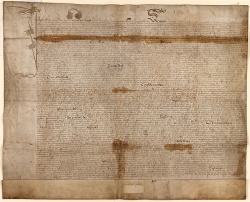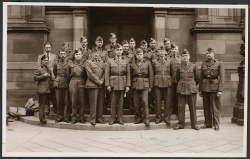Difference between revisions of "Main Page"
| Line 15: | Line 15: | ||
|valign=top align=right width=30%| | |valign=top align=right width=30%| | ||
| − | [[File:0055378d.jpg | border | 250 px | right | thumb]] | + | [[File:0055378d.jpg | border | 250 px | right | thumb | [[Foundation|Foundation Charter]] of James VI to Edinburgh Town Council (1582)]] |
[[File:0009318d.jpg | border | 250 px | right | thumb | Class card issued to [[Charles Darwin]] (1820s)]] | [[File:0009318d.jpg | border | 250 px | right | thumb | Class card issued to [[Charles Darwin]] (1820s)]] | ||
Revision as of 05:28, 18 May 2014
| A growing online history of the University of Edinburgh and its people | |
|
Quick links: Browse by Category : About the Project and Contact Us | |
BeginningsThe University of Edinburgh was established following a Royal Charter in 1582. It was originally called Tounis College, when part of a legacy left by Robert Reid, Bishop of Orkney in 1558 had established a college of which the Town Council had gained control to establish a College of Law on the South side of Edinburgh. The inception of the University took place in 1583. In 1617 when King James VI of Scotland (I of England) visited the College it was decreed that the College should change its name to King James' College, although the College continued to use the older title. CampusThe University opened in 1583 and first classes of the university were held in Hamilton House known as the Duke's Lodge. In 1582 a site that included St Mary in the Fields was acquired. Many new buildings and extensions were made to the site of Hamilton House after 1616. Two prominent stages of building for the University were those undertaken by Robert Adam (1728-1792) and William Henry Playfair (1790-1857). In 1869 the site next to the Edinburgh Royal Infirmary was acquired to construct a new Medical School. Building on this project was completed by the end of the 19th century. The early 20th century saw the acquisitions of the King's Buildings site, and the drift of science from the central area to new purpose-built facilities there. In the mid 20th century major developments took place in the central area, including many new buildings in and around George Square, such as the Basil Spence-designed Main Library. The early 21st century saw saw the bulk of medical teaching switching to new facilities adjacent to the new Infirmary at Little France. Other sites have been added to the campus as a result of the various mergers and the early 21st century has seen a growth of the campus at Easter Bush. CurriculumTeaching began in 1583 under Robert Rollock (1555-1599), with a four year course in arts to gain a masters of arts. When Rollock was appointed as the first principal of the University, there were four Philosophy regents and one regent of Humanity, whilst Rollock specialized in Divinity. Until the beginning of the 18th century the University remained essentially an Arts College, with a Divinity School attached. Throughout the 17th century the Chairs of Divinity, Oriental Languages, Ecclesiastical History and Mathematics had been created. By the end of the 17th century there was also regular teaching in Medicine, and sporadic teaching in Law. The University was at the centre of European Enlightenment in the 18th century. By 1722 a Faculty of Law had been established. The first medical Chair had been established in 1685 and was closely followed in the first half of the 18th century by six more. Four more medical Chairs were created in the 19th century. New Chairs in other Faculties were not established after 1760 until the latter half of the 19th century when they followed in rapid succession, continuing in the 20th century, including those resulting from merger. Colleges and SchoolsIn 2002, the structure of the university was altered substantially, with the abolition of Faculties and the creation of the College of Humanities and Social Science, the College of Medicine and Veterinary Medicine and the College of Science and Engineering. Departments were also reorganised and replaced by Schools. GovernanceThe University was governed by the town council until the Universities (Scotland) Act 1858, when it received self governing status. The archaic teaching and management system of Regents was abolished in 1708. The 1858 act dramatically changed the constitution of the University. A University Court and General Council were introduced which decided on matters and management pertaining to the whole University. The Senatus Academicus was already in place before 1858 and this managed academic matters, but, from 1889, answered to Court. This system is still used. MergersThe first change in the corporate body of the University was not until 1935 when the first merger took place. This was between the Faculty of Divinity of the University of Edinburgh and New College, preciptated by the re-union of the Church of Scotland in 1932.The next merger came in 1951 when the Royal (Dick) Veterinary School was reconstituted as part of the University of Edinburgh. It achieved full faculty status in 1964. In 1998 Moray House Institute of Education became the Faculty of Education and, in 2011, Edinburgh College of Art became part of the University. During WW2, the Polish School of Medicine was constituted within the Faculty of Medicine but with its own autonomy. Long-established links between the University and the Roslin Institute resulted in merger in 1997. |
 Foundation Charter of James VI to Edinburgh Town Council (1582)  Class card issued to Charles Darwin (1820s)
 Staff and students at the Polish School of Medicine (1940s) |